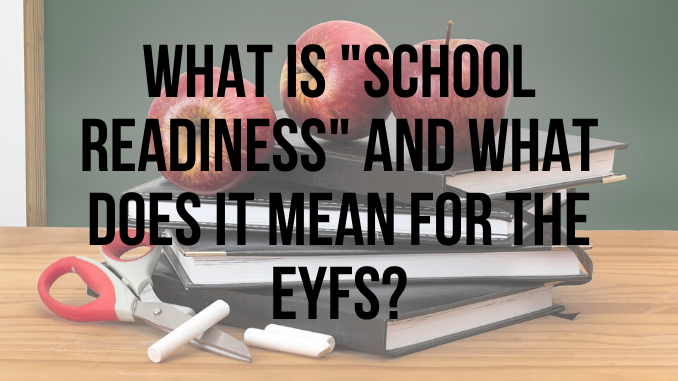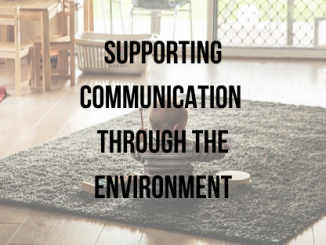School readiness is not a new term in Early Years by any means, but it has certainly seen renewed and more intensive interest in recent years. The definition of children’s readiness for school has undergone major shifts during the past four decades; it is now accepted that school readiness is largely a socially constructed concept. Former approaches stressed the maturity level of the child, to allow for quiet, focused work associated with ‘school’ (Gesell, Ilg and Ames 1974; Pandis 2001) but more recent approaches stress the relationship between the child and their environment (Murphy and Burns 2002).
These newer perspectives suggest that in achieving a ‘good fit’ between the child and the environment optimal development is supported (Graue 1992). UNICEF (2012) suggests ‘School readiness is a product of the interaction between the child and the range of environmental and cultural experiences that maximize the development outcomes for children”
However, in recognising that the concept of ‘school readiness; is socially constructed we also must recognise that it will vary widely across the globe, as do school starting ages, education style and cultural expectation. Thus, there is no Universal state of being “Ready for school”
In the UK ‘school readiness’ has been growing as a concept, and generally seems to be considered a measure of how intellectually, socially and emotionally ready children are to succeed in school. The problem is that it seems to be a popular practice to use the Early Learning Goals from the EYFS, to measure whether a child has reached a ‘Good Level of Development’ (GLD) and is, therefore ‘ready for school’ but children typically reach statutory school age, and begin at school, in the last year of the EYFS, sometimes called ‘Foundation 2’ or ‘Reception’ and some children are in maintained schools even earlier than this (In 2-year-old provision, or Foundation 1 classes) The concept of “School Readiness” is far from clear cut.
The dangers of the ‘school readiness’ agenda
The main danger of the school readiness agenda is that it is misunderstood by parents and practitioners and used as leverage for narrowing of the curriculum. That is, in order to ‘get children ready for school’ we begin more formal instruction when it is not developmentally appropriate to do so, or else begin to move the GLD goalposts forwards to younger children and push for reading, writing, and formalised mathematics.
Indeed, many a day nursery and foundation 1 class has fallen victim to the push for phonics teaching earlier and earlier, and flashcards and worksheets are sadly not an uncommon sight. The sharp focus on ‘ready children’ has sadly led to a perceived pressure on practitioners to ensure that certain criteria are met before children leave their care and this drives a ‘tick-box’ approach to the curriculum.
A positive way forward
The ‘school readiness’ agenda seems like it’s here to stay, so it is important to find a way to circumvent the dangers of narrowing the curriculum, a tick-box approach or moving goalposts forwards.
School readiness needs to be discussed as the broader concept that it actually is, and not narrowed down to simply ‘Ready children’. Ready children is one strand of the School readiness concept but it is not the whole of it and needs to be defined in terms other than the GLD.
Another strand of the school readiness concept is that of ready schools; this places some emphasis and responsibility on the receiving school to be ready to support and teach children in ways that are age and stage appropriate. Education experiences prior to primary school are varied and disparate across the globe (UNESCO 2007). But they do have one characteristic in common: Most early childhood care and education programmes differ greatly compared to the education philosophy, teaching style and structure of primary school. Creating continuity and maintaining learning expectations for children between early learning and primary school environments is a defining characteristic of ready schools (Lombardi 1992) Here Early years advocates can and should play a significant role in advocating for appropriately trained teachers, appropriately broad curriculum and appropriate validity given to the uniqueness of the Early Years Foundation Stage; the EYFS was never intended to be a mini-version of school, it is something within it’s own right and not ‘Key stage zero’.
The final strand of the school readiness concept is ‘Ready families’ which is intended to recognise the significant role that parents, carers and whole families play in children’s educations. When looking at school readiness in London (Public Health England; 2015) a further idea of ‘ready communities’ was added, recognising the important role and impact that community services such as midwifery services, health visiting teams, and children’s centres have on helping families to be involved in their children’s early learning, development and transitions into school.
When we talk about School Readiness and the EYFS it is easy to become focused on ‘ready children’ and by extension, the curriculum and opportunities provided within the EYFS. We must resist the temptation to take on the full responsibility for school readiness, and certainly resist top-down pressure to change good Early Years practice for the sake of fulfilling a checklist. Instead, we should recognise the role of the EYFS and settings as part of a three-pronged approach to school readiness and ensure that we advocate for developmentally appropriate practice throughout the whole of the Early Years Foundation Stage.
References:
Gesell, A., Ilg, F., & Ames, L. B. (1974). The Gesell Institute’s child from one to six: Evaluating the behavior of the preschool child. New York: Harper & Row.
Graue, M. Elizabeth, ‘Social Interpretations of Readiness for Kindergarten’, Early Childhood
Quarterly, vol. 7, no. 2, June 1992, pp. 225–243.
Lombardi, Joan, ‘Beyond Transition: Ensuring continuity in early childhood services’, ERIC
Digest, Education Information Resources Information Center, available at: www.eric.ed.gov/PDFS/ED345867.pdf
Murphy, David A., and Catherine E. Burns, ‘Development of a Comprehensive Community
Assessment of School Readiness’, Early Childhood Research and Practice, vol. 4, no. 2, 2002,
pp. 1–15.
Pandis, M. (2001) School Readiness or School’s readiness? In: “Thinking Classroom” International Reading
Association and Open Society Institute, No. 3, 2001, pp.23-28.
Public Health England (2015) Improving school readiness: Creating a better start for London, available at: https://www.gov.uk/government/publications/improving-school-readiness-creating-a-better-start-for-london
United Nations Educational, Scientific and Cultural Organization, EFA Global Monitoring Report
2007: Strong foundations – Early childhood care and education, UNESCO, Paris, 2007.
UNICEF (2012)School Readiness; a Conceptual framework, available at: https://www.unicef.org/earlychildhood/files/Child2Child_ConceptualFramework_FINAL(1).pdf







